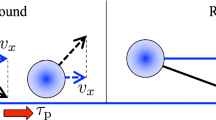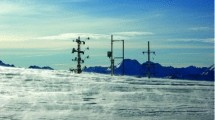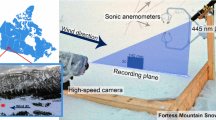Abstract
An atmospheric surface-layer model is used to investigate the interactionbetween suspended snow particles and the near-surface flow. Themodel incorporates the effects of upward diffusion, gravitational settling and sublimation of snow particles in 48 size classes, the effects of snowdrift sublimation on the heat and moisture budget of the surface layer, and the buoyancy destruction of turbulent kinetic energy (TKE) caused by the presence of suspended particles. A new term in the E-ε closure model representing the buoyancy destruction due to suspended particles is included in the prognostic equation for TKE. Generally, model results indicate that the presence of suspended particles causes significant decreases in TKE, the dissipation rate, turbulent length scales and eddy exchange coefficients (up to 40%). It is found that the reduction in the eddy exchangecoefficients is due mainly to reductions in turbulent length scales. Theassociated particle Richardson number peaks near the saltation-suspensioninterface, but at higher levels in the surface layer the particle-induced buoyancy can also significantly affect the flow. A detailed analysis of the various snowdrift quantities, the TKE budget and the particle buoyancy effects on the flow is presented.
Similar content being viewed by others
References
Adams, C. E., Jr. and Weatherly, G. L.: 1981, ‘Some Effects of Suspended Sediment Stratification on an Oceanic Bottom Boundary Layer’, J. Geophys. Res. 86, 4161–4172.
Bintanja, R.: 1998a, ‘The Interaction between Drifting Snow and Atmospheric Turbulence’, Ann. Glaciol. 26, 167–173.
Bintanja, R.: 1998b, ‘The Contribution of Snowdrift Sublimation to the Surface Mass Balance of Antarctica’, Ann. Glaciol. 27, 251–259.
Bintanja, R.: 2000, ‘Snowdrift Suspension and Atmospheric Turbulence. Part I: Theoretical Background and Model Description’, Boundary-Layer Meteorol. 95, 343–368.
Déry, S. J. and Taylor, P.A.: 1996, ‘Some Aspects of the Interaction of Blowing Snow with the Atmospheric Boundary Layer’, Hydrol. Proc. 10, 1345–1358.
Déry, S. J., Taylor, P. A., and Xiao, J.: 1998, ‘The Thermodynamic Effects of Sublimating Snow in the Atmospheric Boundary Layer’, Boundary-Layer Meteorol. 89, 251–283.
Dover, S. E.: 1993, ‘Numerical Modelling of Blowing Snow’, Ph.D. Thesis, University of Leeds, 223 pp.
Dyer, K. R.: 1986, Coastal and Estuarine Sediment Dynamics, Wiley & Sons Ltd., Chichester, 342 pp.
Garratt, J. R.: 1992, The Atmospheric Boundary Layer, Cambridge University Press, Cambridge, 316 pp.
Hino, M.: 1963, ‘Turbulent Flow with Suspended Particles’, J. Hydraul. Div. Am. Soc. Civ. Eng. 89(HY4), 161–185.
Kobayashi, S.: 1979, ‘Studies on Interaction between Wind and Dry Snow Surface’, Contrib. Inst. Low Temp. Sci. Hokkaido Univ., Ser. A, no. 29, 64 pp.
Lumley, J. L.: 1978, ‘Two-Phase and Non-Newtonian Flows’, in P. Bradshaw (ed.), Topics in Applied Physics, Vol. 12, Springer, New York, 289–324.
Mann, G. W.: 1998, ‘Surface Heat and Water Vapour Budgets over Antarctica. Ph.D. Thesis, University of Leeds, 279 pp.
McKenna Neuman, C. and Maljaars, M.: 1997, ‘Wind Tunnel Measurements of Boundary-Layer Response to Sediment Transport’, Boundary-Layer Meteorol. 84, 67–83.
Nishimura, K., Sugiura, K., Nemoto, M., and Maeno, N.: 1998, ‘Measurements and Numerical Simulations of Snow Particle Saltation’, Ann. Glaciol. 26, 184–190.
Pomeroy, J. W. and Gray, D. M.: 1990, ‘Saltation of Snow’, Water Resour. Res. 26,1583–1594.
Pomeroy, J.W. and Male, D. H.: 1992, ‘Steady-State Suspension of Snow’, J. Hydrol. 136, 275–301.
Smith, J. D. and McLean, S. R.: 1977, ‘Boundary Layer Adjustments to Bottom Topography and Suspended Sediment’, in J. Nihoul (ed.), Bottom Turbulence, Elsevier, New York, pp. 123–151.
Taylor, P. A. and Dyer, K. R.: 1977, Theoretical Models of Flow near the Bed and their Implications for Sediment Transport’, in E. D. Goldberg (ed.), The Sea, Vol. 6,Wiley-Interscience, New York, pp. 579–601.
Xiao, J., Bintanja, R., Déry, S. J., Mann, G., and Taylor, P. A.: 1999, ‘An Intercomparison between ThreeModels of Blowing Snow in the Atmospheric Boundary Layer’, Boundary-Layer Meteorol. (submitted).
Yalin, M. S.: 1972, Mechanics of Sediment Transport, Pergamon, New York, 290 pp.
Author information
Authors and Affiliations
Rights and permissions
About this article
Cite this article
Bintanja, R. Snowdrift Suspension And Atmospheric Turbulence. Part II: Results Of Model Simulations. Boundary-Layer Meteorology 95, 369–395 (2000). https://doi.org/10.1023/A:1002643921326
Issue Date:
DOI: https://doi.org/10.1023/A:1002643921326




